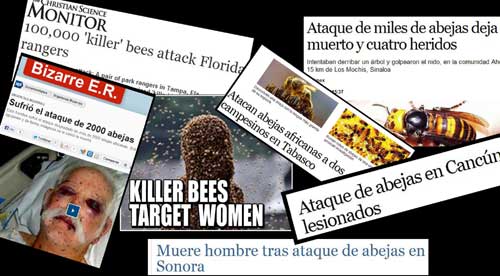|
By John Pint
 Guadalajara, Mexico, May 29, 2013. Guadalajara, Mexico, May 29, 2013.
During
a walk in the woods last week, the subject of Africanized bees came up.
I asked my fellow hikers what was the worst bee attack they had ever
heard about. Veteran excursionista Mario Guerrero responded, “Without a
doubt, it was the death of Enedino Luna.” Luna, he explained, had been
a guide and trainer for Grupo Colli, the most active
organization for hiking and camping here in Guadalajara, Mexcio.
Approximately 12 years ago, Luna took a group of young climbers into
the hills near Magdalena to practice rappelling. “He stood on the edge
of a cliff supervising the descent of the others. Somehow the
rappellers disturbed a hive of bees on the way down and were
immediately attacked. They responded by sliding down the rope even
faster, and managed to reach the bottom and escape. Unfortunately, the
bees also swarmed upwards, discovered Enedino Luna at the top of the
drop and totally engulfed him.”
Luna died from the great amount
of stings he suffered and later an autopsy was performed on his body.
“They found Enedino’s stomach full of bees,” my informant reported.
Trying
to find out if “killer bee” attacks are still a problem in Mexico, I
searched the web and discovered all sorts of recent stories.
I
learned that just a few weeks ago bees attacked two adults and two
small children near a hotel in downtown Cancun. The people survived,
but, curiously, the bees managed to kill a large number of pigeons.
Last
August in Navojoa, an eight-year-old boy died and three friends were
badly hurt when bees swarmed all over them atop a water tank. One child
saved himself by jumping into the water, but firemen trying to rescue
him had to retreat because of the ferocity of the attack.
In
2011, a 63-year-old man was killed by bees near Los Mochis, while two
campesinos in Villahermosa were attacked while cycling across a bridge
and ended up "nearly dead" in a local hospital. Meanwhile in Veracruz,
a 72-year-old tourist guide died when a swarm of bees overwhelmed him
and ten tourists during a visit to a cave famed for its petroglyphs.
Perhaps
the most curious event took place in Chiapas, where 70 policemen were
hospitalized when Africanized bees interrupted their target practice.
The police found their guns useless against the bees, threw them to the
ground and ran for their lives.
Closer to home, more than 20
people were hospitalized in Uruapan, Michoacan when bees attacked
Electric Company workers who were trying to take down a hollow tree.
Numerous passersby and motorists were also attacked. Curiously, three
of the people who ended up in the hospital were firemen who had been
called in to control the attack.
I mentioned some of these
incidents to Engineer Francisco Javier Pineda, a member of a special
committee which was set up back in 1991 to control Africanized bees in
Metro Guadalajara. “Yes,” he said, “in rural areas there are plenty of
cases like those you described, but do you have any idea how many bee
attacks we have right here inside the city of Guadalajara?”
Well, I had always considered Killer Bees a country problem. “Er, maybe
50 a year?” I ventured.
To my surprise, Engineer Pineda replied that Guadalajara has from 200
to 300 attacks per month,
necessitating speedy and well-coordinated responses on the part of
Protección Civil, Police, Firemen, Red Cross and other agencies. Just
how speedy this response might be is not clear. When Paul King of
Guadalajara discovered a bee hive in a tree in his back yard, he
immediately called Protección Civil, but they never showed up. King
finally had to call a fumigator, whose manner of resolving the problem
was to kill all the bees. “On another occasion,” adds King, “I called
Protección Civil on a holiday and got no reply throughout the entire
day.”
Curious as to whether such incidents are also happening in
the USA (where Africanized bees arrived at the turn of the century) I
discovered that less than a month ago a Florida man bathing his dog was
attacked by bees which apparently didn’t like the smell of the shampoo
the man was using. The dog owner first tried to fight off the bees with
his garden hose, to no avail. “The bees started swarming down and they
just covered my face,” said Robert Denmark, 65. The only way I got them
off me was I lit a fire.” Denmark was stung again and again in the
face, but survived. Not so fortunate was his 80 pound Rottweiler, which
was rushed to the vet, but nevertheless died.
 Some time ago I
reported that a Texan
had invented a simple solution for warding off attacks of bees
like those mentioned above. Will Baird of Houston lost a good friend to
an Africanized Bee attack in 2004 and thereafter began research on how
to halt bee attacks while doing the least damage to the victims, the
environment and to the bees themselves. His solution was BeeAlert,
a harmless, non-toxic spray. You aim the spray straight upward and as
it falls back down, it creates a “halo” around you…and the victims.
Because the spray interferes with the bees’ breathing, those who enter
the “halo” immediately signal the swarm that this place is dangerous
and the cloud of bees moves upward and away, ending the attack and
allowing the victims time to escape. It took Baird years to perfect
what he calls “The BeeAlert Stinging Insect Control System” and only
recently has he begun distributing the spray in the USA. “I am looking
for a distributor for Mexico,” says Baird, “and I hope BeeAlert will
soon be available all over the country.” Some time ago I
reported that a Texan
had invented a simple solution for warding off attacks of bees
like those mentioned above. Will Baird of Houston lost a good friend to
an Africanized Bee attack in 2004 and thereafter began research on how
to halt bee attacks while doing the least damage to the victims, the
environment and to the bees themselves. His solution was BeeAlert,
a harmless, non-toxic spray. You aim the spray straight upward and as
it falls back down, it creates a “halo” around you…and the victims.
Because the spray interferes with the bees’ breathing, those who enter
the “halo” immediately signal the swarm that this place is dangerous
and the cloud of bees moves upward and away, ending the attack and
allowing the victims time to escape. It took Baird years to perfect
what he calls “The BeeAlert Stinging Insect Control System” and only
recently has he begun distributing the spray in the USA. “I am looking
for a distributor for Mexico,” says Baird, “and I hope BeeAlert will
soon be available all over the country.”
Africanized bees become
upset much more easily than normal honeybees. In a city you can always
call 911 in the States or 066 in Mexico, but if you plan to take a walk
in the country, what can you do to minimize the danger of a bee attack?
For
one thing, you can avoid wearing colors that infuriate them, such as
black and brown as well as bright and shiny jewelry or objects. In
addition, don’t use perfumes, perfumed deodorants or anything that
smells lemony. Loud noise also sets them off, especially the sound and
vibrations of tractors and bulldozers.
If you are
walking, your best protection is your hearing. If you keep your ears
open, you can usually hear the hum of a hive before you walk into the
“hot zone” and you should immediately backtrack.
If bees come
after you and you’re in a flat area, you may be able to escape simply
by outrunning them. Head upwind, if possible. As for jumping into
water, some people have saved themselves in this way, but others say
the bees just hang around waiting until you surface.
If you are
stung, use a credit card to remove the stings. In this way, you can
avoid squeezing them, because each sting contains poison and continues
to pump it into your body even after the bee is dead. An antihistamine
like Avapena (available in any Mexican pharmacy) can give you an extra
hour to get to a hospital.
Of course, the ideal would be to
carry a can of BeeAlert in your vehicle or backpack. Let’s hope Will
Baird’s invention will soon be available in Mexico, where it is
definitely needed, because, as Baird says, “The Africanized Honeybee is
here to stay.”
For more information on this subject, check out “What to Do About Mexican Killer Bees.”
|

